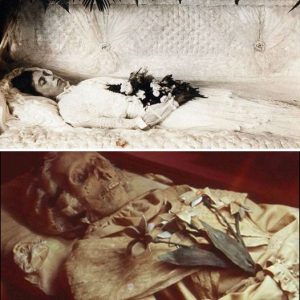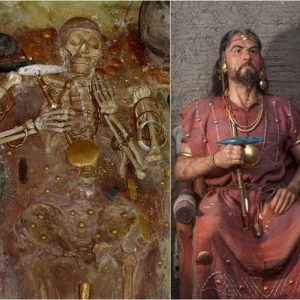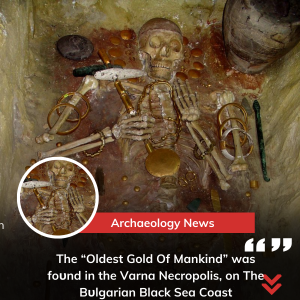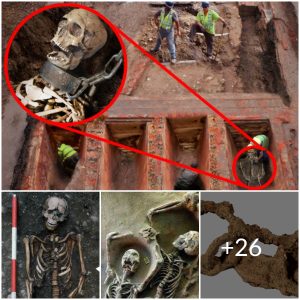During a recent excavation in Jerusalem, archaeologists searching through the rubble of a building constructed during the First Temple period found something unusual. Inside one room, they discovered the 2,700-year-old skeletal remains of a small pig. The animal appeared to have been crushed to death by falling debris, during some type of mysterious event that caused serious damage to the building as a whole.

First Temple period structures near the Gihon Spring in Jerusalem’s City of David, where the pig skeleton was found along with the “butchered” remains of many other types of animals. (Joe Uziel / Israel Antiquities Authority)
Inside the same room, the archaeologists also found the skeletal remains of many other animals. These bones were eventually identified as belonging to a wide variety of species, including cattle, goats, sheep, fish, birds, and gazelles. Tellingly, most of these bones showed signs of having been cut and burned. The archaeologists also unearthed several large storage vessels and small cooking pots.
Pig Skeleton Suggests Pork Was On the Menu in Jerusalem

Taken all together, these discoveries reveal that animals were being killed and butchered on site, so their meat could be cooked and eaten by ancient residents of Jerusalem in the First Temple Kingdom of Judah. The small pig would have been added to the menu eventually but was apparently alive when the building was destroyed by some unknown force (there is no record of an earthquake in Jerusalem at that time).
What makes this find notable is that it is forbidden to consume pigs (and thus any kind of pork) in the Jewish religion, under the laws of Kashrut. These Bible-based prohibitions are taken from writings found in two Old Testament books, Leviticus and Deuteronomy. These laws say that Jewish people should only consume animals that have cloven hooves and chew their cud—which rules pigs out.
In this case, it is clear that this prohibition was being ignored by someone. Perhaps this was unusual behavior, or perhaps it was more common than might be expected.

An archaeologist retrieves the skull of a piglet from a First Temple period building in Jerusalem’s City of David at the site where the “articulated” pig skeleton was also found. (Joe Uziel / Israel Antiquities Authority)
“It appears that this articulated pig may be evidence that although pork was largely not consumed in Judah and Jerusalem, this was not necessarily based on a very strict taboo. The extent of culinary consumption based on laws of Kashrut in the Iron Age is still debatable.”
So wrote co-authors Lidar Sapir-Hen, Joe Uziel and Ortal Chalaf, the Israeli archaeologists responsible for this discovery, in an article prepared for the journal Near East Archaeology.Pigs and thus pig skeleton remains account for about two percent of the animal remains that have been found in First Temple-period excavations in the city of Jerusalem. This number is low, but obviously higher than expected if dietary prohibitions were strictly observed.
Religious Rules vs. the Privileges of Wealth
Intriguingly, the archaeologists found evidence showing that the building where the pig remains were found belonged to a wealthy family, and that it was their place of residence.
The building included four rooms in total and was constructed from rough field stones. Excavations there uncovered valuable personal artifacts, including several pieces of fine jewelry and an intricately carved human figurine. The home was built near the Gihon spring, Jerusalem’s main source of fresh water at that time (making that location prime real estate).
While the structure was likely constructed as a private residence, it may have had another function. In one room, the archaeologists discovered a type of ancient stamping device known as a bulla. These objects were flat stones that contained the markings of city or regional administrators, whose duties would include putting their official seal of approval on vital documents or other items of value. The presence of the bulla suggests the home belonged to an important public official, whose seal would have been recognized as legally binding.
Since the room where animals were killed and butchered was privately owned, it is possible that its owners were killing and eating pigs in secret. It’s also possible their activities were known, but they were able to get away with it because they were wealthy and influential.
If the latter suggestion is true, it would follow a familiar historical pattern. Like so many other societies, both present and past, ancient Jerusalem may have had two sets of rules, one for the rich and another for everyone else.
How Much Did the Bible Really Matter in First Temple Jerusalem?

The Givati Parking Lot excavations in the City of David Park in Jerusalem, a site where remnants of the 586 BC destruction of Jerusalem by the Babylonians were discovered. It was at this site that the pig skeleton and other animals remains were discovered. (Shai Halevi / Israel Antiquities Authority)
There is another possibility, according to study co-author Lidar Sapir-Hen. He claims that pigs were rarely kept in most areas of the Ancient Near East during that era, and that scarcity likely had more to do with limiting their consumption than Biblical prohibitions.
As evidence for this theory, he notes that excavations at Late Bronze Age sites (from the second millennium BC) have seldom produced pig remains. This is significant, because the Bible (Old Testament) was only written later, during the Iron Age (in the first millennium BC).
Furthermore, pig remains have seldom been found at Iron Age sites elsewhere in the region, Sapir-Hen states. Excavations at sites linked to the ancient Canaanites, Phoenicians, Arameans, and Philistines have produced little evidence of regular pig meat consumption.
It seems that pig populations in the Ancient Near East were low everywhere, and as a result pig meat was not commonly eaten.
As for the Biblical prohibitions, most scholars now believe that the Old Testament was only written down in its recognizable final form during the period of the Second Temple, which lasted from 516 BC to 70 BC. Parts of it were composed during the First Temple period, but not the majority.
Studies have shown that religious practices in the First Temple kingdoms of Israel (north) and Judah (south) were diverse and eclectic and varied from location to location. Consequently, Biblical rules (as currently understood) didn’t always apply. This may have included rules against eating pigs, which may or may not have existed at that time (and may not have been universally respected if they did).
If scarcity rather than religious rules kept pigs from being widely consumed in the Iron Age Kingdom of Judah, their meat might have been considered a delicacy. Pigs might have been quite expensive to purchase, making their meat unaffordable for all but the wealthiest citizens of Jerusalem. That would explain why the archaeologists involved in this new study discovered the pig skeleton where they did, in the residence of an elite member of ancient Jerusalem society.





